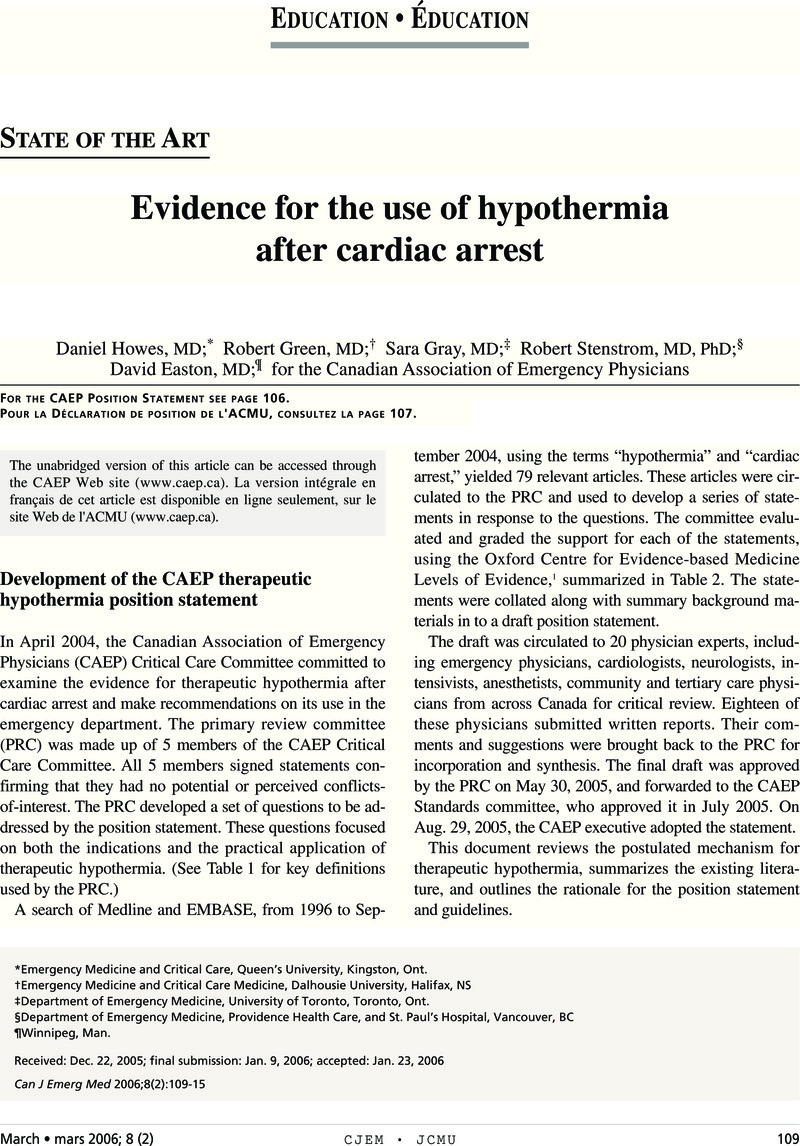Crossref Citations
This article has been cited by the following publications. This list is generated based on data provided by Crossref.
Cheung, Ka Wai
Green, Robert S.
and
Magee, Kirk D.
2006.
Systematic review of randomized controlled trials of therapeutic hypothermia as a neuroprotectant in post cardiac arrest patients.
CJEM,
Vol. 8,
Issue. 05,
p.
329.
Zed, Peter J.
Abu-Laban, Riyad B.
Shuster, Michael
Green, Robert S.
Slavik, Richard S.
and
Travers, Andrew H.
2008.
Update on cardiopulmonary resuscitation and emergency cardiovascular care guidelines.
American Journal of Health-System Pharmacy,
Vol. 65,
Issue. 24,
p.
2337.
Brooks, Steven C.
and
Morrison, Laurie J.
2008.
Implementation of therapeutic hypothermia guidelines for post-cardiac arrest syndrome at a glacial pace: Seeking guidance from the knowledge translation literature.
Resuscitation,
Vol. 77,
Issue. 3,
p.
286.
Kim, Young-Min
Jeong, Ju-Hwan
Kyong, Yeon-Young
Kim, Han-Joon
Kim, Ji-Hoon
Park, Jeong-Ho
and
Park, Kyu-Nam
2008.
Use of cold intravenous fluid to induce hypothermia in a comatose child after cardiac arrest due to a lightning strike.
Resuscitation,
Vol. 79,
Issue. 2,
p.
336.
Kennedy, Joel
Green, Robert S.
and
Stenstrom, Robert
2008.
The use of induced hypothermia after cardiac arrest: a survey of Canadian emergency physicians.
CJEM,
Vol. 10,
Issue. 02,
p.
125.
Chamorro, Carlos
Borrallo, Jose M.
Romera, Miguel A.
Silva, Jose A.
and
Balandín, Bárbara
2010.
Anesthesia and Analgesia Protocol During Therapeutic Hypothermia After Cardiac Arrest.
Anesthesia & Analgesia,
Vol. 110,
Issue. 5,
p.
1328.
Binks, A. C.
Murphy, R. E.
Prout, R. E.
Bhayani, S.
Griffiths, C. A.
Mitchell, T.
Padkin, A.
and
Nolan, J. P.
2010.
Therapeutic hypothermia after cardiac arrest – implementation in UK intensive care units*.
Anaesthesia,
Vol. 65,
Issue. 3,
p.
260.
Howes, Daniel
Ohley, William
Dorian, Paul
Klock, Cathy
Freedman, Robert
Schock, Robert
Krizanac, Danica
and
Holzer, Michael
2010.
Rapid induction of therapeutic hypothermia using convective-immersion surface cooling: Safety, efficacy and outcomes.
Resuscitation,
Vol. 81,
Issue. 4,
p.
388.
Dainty, Katie N
Scales, Damon C
Brooks, Steve C
Needham, Dale M
Dorian, Paul
Ferguson, Niall
Rubenfeld, Gordon
Wax, Randy
Zwarenstein, Merrick
Thorpe, Kevin
and
Morrison, Laurie J
2011.
A knowledge translation collaborative to improve the use of therapeutic hypothermia in post-cardiac arrest patients: protocol for a stepped wedge randomized trial.
Implementation Science,
Vol. 6,
Issue. 1,
Boyko, Mark
and
Lang, Eddy
2011.
Is Therapeutic Hypothermia for Closed Head Trauma Beneficial?.
Annals of Emergency Medicine,
Vol. 57,
Issue. 5,
p.
537.
Azmoon, Shah
Demarest, Caitlin
Pucillo, Anthony L.
Hjemdahl-Monsen, Craig
Kay, Richard
Ahmadi, Naser
Aronow, Wilbert S.
and
Frishman, William H.
2011.
Neurologic and Cardiac Benefits of Therapeutic Hypothermia.
Cardiology in Review,
Vol. 19,
Issue. 3,
p.
108.
Yokobori, Shoji
Bullock, M. Ross
and
Dietrich, W. Dalton
2012.
Therapeutic Hypothermia After Cardiac Arrest.
p.
25.
Greenberg, Steven B.
and
Vender, Jeffery
2013.
The Use of Neuromuscular Blocking Agents in the ICU.
Critical Care Medicine,
Vol. 41,
Issue. 5,
p.
1332.
Leal Forero, Laura Catalina
Martínez Malo, Luz Catherine
and
Navarro Vargas, José Ricardo
2014.
La reanimación cerebro cardiopulmonar: estado del arte.
Revista de la Facultad de Medicina,
Vol. 62,
Issue. 1,
p.
149.
Howes, Daniel
Gray, Sara H.
Brooks, Steven C.
Boyd, J. Gordon
Djogovic, Dennis
Golan, Eyal
Green, Robert S.
Jacka, Michael J.
Sinuff, Tasnim
Chaplin, Timothy
Smith, Orla M.
Owen, Julian
Szulewski, Adam
Murphy, Laurel
Irvine, Stephanie
Jichici, Draga
and
Muscedere, John
2016.
Canadian Guidelines for the use of targeted temperature management (therapeutic hypothermia) after cardiac arrest: A joint statement from The Canadian Critical Care Society (CCCS), Canadian Neurocritical Care Society (CNCCS), and the Canadian Critical Care Trials Group (CCCTG).
Resuscitation,
Vol. 98,
Issue. ,
p.
48.
Hart, Lindsay
and
Newton, Paul
2017.
Therapeutic hypothermia in cardiac arrest.
Journal of Paramedic Practice,
Vol. 9,
Issue. 3,
p.
126.
Shankar, Jai Jai Shiva
Stewart-Perrin, Brandie
Quraishi, Ata-Ur-Rehman
Bata, Iqbal
and
Vandorpe, Robert
2018.
Computed Tomography Perfusion Aids in the Prognostication of Comatose Postcardiac Arrest Patients.
The American Journal of Cardiology,
Vol. 121,
Issue. 7,
p.
874.



